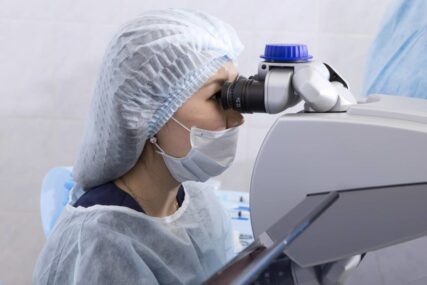In the Journals: Topography-Guided LASIK

Today’s vision correction patients have many advanced technologies to choose from to customize a procedure including topography-guided LASIK. In this article, we provide an overview of a recent clinical study, “Topography Guided LASIK: A Prospective Study Evaluating Patient Reported Outcomes”. This research is notable because it examines topography-guided LASIK using a version of the FDA’s Patient Reported Outcomes With LASIK questionnaire to gather patient-reported data.
The Purpose of the Study
The research team believes this study is the first to report findings from outcomes of topography-guided LASIK procedures “primarily focused on quality of vision from the patient’s perspective.” Topography-guided LASIK allows the surgeon to treat the irregularities of the cornea to improve vision which cannot be accomplished with a conventional LASIK or glasses.
How the Study was Done
Forty-six patients had topography-guided LASIK on both eyes (n=92) at a single private practice between October 2021 and November 2022. Each patient was given a survey before surgery and then again one week, one month, three months, and six months after surgery. The survey questions asked patients about their level of satisfaction with their vision, eye and/or visual symptoms and challenges those issues may present.
The researchers then analyzed the patient survey data in combination with the clinical outcomes of the patients’ topography-guided LASIK procedures.
The Results of the Study
The results of the patient-reported survey data showed patients were significantly more satisfied with their vision after topography-guided LASIK than with their previous glasses or contact lenses. In fact, 100% of patients reported a maximum satisfaction score (5 out of 5) after their procedure.
Patients also reported improvements in night vision, glares, halos, starbursts, and dry eye symptoms after having the procedure. However, double image symptoms were not significantly improved after topography-guided LASIK.
Clinically speaking, the outcomes of the procedures were excellent, concluding the procedure is both safe and effective for those who are qualified candidates:
- 100% of patients achieved 20/20 or better vision without correction after topography-guided LASIK
- 100% of patients achieved 20/16 vision without correction after the procedure
- No complications were reported during the 6-month follow-up period
- No patients had an enhancement during the 6-month follow-up period
This study is among the first to follow the recent recommendations from the FDA to include vision quality measurements as part of the evaluation of LASIK outcomes. The results of the study confirm that topography-guided LASIK can improve the quality of vision compared to glasses or contact lenses. Also, it indicates that the preoperative consultation and informed consent process should include a discussion of both the potential risks and benefits of a procedure with regard to symptoms such as difficulty with night vision, glares, halos, starbursts, and dry eye symptoms.




